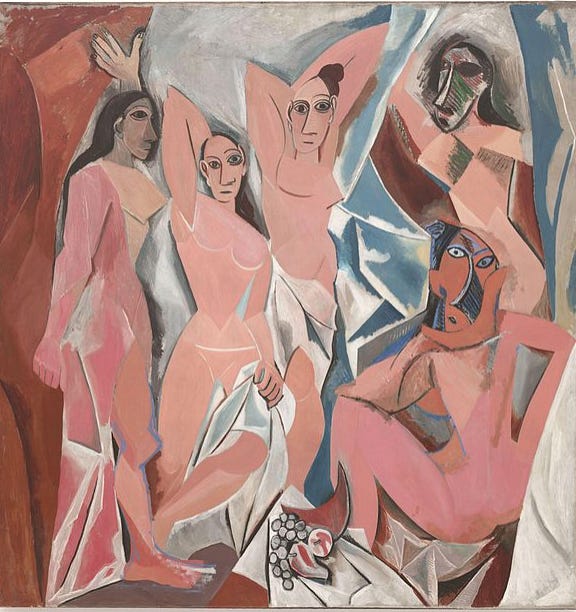The Floundering Contemporary Art World
Corporate repackaging with woke values is the ultimate dead end.
I’ve often thought that modern art was born and it reached its apotheosis at one and the same time in the mind of Pablo Picasso when he painted Les Demoiselles d'Avignon in 1907. As a young man in Barcelona, he found himself irresistibly drawn to a brothel in the Carrer d'Avinyó—a narrow street located in the city’s El Gotic district. In his portrait of the young women who worked in the brothel, he expressed—as only Picasso could—the primitive fascination and horror he felt for his own obsession with women. As he later described it, the act of painting it enabled him to “liberate an utterly original artistic style of compelling, even savage force.” At the same time, he understood that it was too shocking revolutionary to exhibit, and he didn’t do so until almost nine years later, at the urging of the poet Andre Salmon in Paris.
It seems to me that with this masterpiece, Picasso created an impossible act to follow. And here lies the problem with modernism as an artistic genre. After one great artist subverted the Western aesthetic tradition with one fascinating painting, there was no where to go from there.
Years ago, when I lived in Barcelona, I often strolled down the Carrer d'Avinyó and stopped in front of the building where the brothel was housed to ponder this strange state of affairs. Below is a photograph I took of the facade.
What are the aesthetic values expressed in modernist paintings beyond deconstructing traditional aesthetic values? Can modernist paintings be repackaged to express the culture industry’s current obsessions?
I pondered these questions yesterday here in Vienna when I saw an advertisement for the Leopold Museum’s large collection of Austrian and German modernist paintings, most of which were painted between roughly 1900 and 1930. The advertisement strikes me as the lamest piece of corporate repackaging I’ve ever seen.
The pastiche of images is assembled from various portraits in the Leopold Museum that have nothing whatsoever to do with the current fetish for “Diversity.” The tossing in of photographs of Sigmund Freud and Gustav Klimt (holding a cat) is totally contrived. To drive the “Diversity” theme home, the ad includes an image of a dancer from Madagascar named Rasha who performed in Weimar Germany and was the subject of a 1929 portrait by Christian Schad.
The Museum describes the exhibition as follows:
By means of wooden sticks held up by stylized hands placed underneath the works, the exhibits become protest placards. Thought-provoking accompanying texts provide further information, and establish a connection between the works and the challenges of our time.
The themes of the initiative WE ARE MANY. CELEBRATING DIVERSITY range from a plea for social diversity and the importance of feminism, via appeals for climate protection, the appreciation of education and labor, as well as against war, hunger and poverty, all the way to questions of gender identities and sexual orientation.
The world of modern art museums and galleries—which are largely the domain of extremely rich people trying to be radically chic—has long been infamous for producing ridiculous prose to describe the aesthetic and moral values purportedly expressed in grossly overpriced paintings. However, with “WE ARE MANY: Celebrating Diversity,” the people who run the Leopold Museum have reached a new summit of absurdity.








It's not just art museums. Whenever we travel we seek out the local history museums. A couple years ago we came across an exhibit about homesteaders in the Midwest. It was a feminist take on the settlers lives, bemoaning the fact that the husbands would frequently take off to hunt or explore, leaving the wives to manage the farm or ranch alone with the dozen or so kids they had. I practically laughed out loud, wondering what my great grandmother forbears would have thought had they heard their lives described that way. It was the modern feminist view of marriage - women do all the work while men do what they want - projected on people who lived 150 years ago. The DEI crowd have a very narrow, false view of the world and the people in it, and no understanding at all of the generations who came before them. As a result they have no real understanding of humanity, and that false view is what allows them to believe in fictions like socialism, gender theory, toxic masculinity and "the patriarchy."
I think you may have been misled by a 'false summit' (lower summit that hides the climber's view of the higher summit further on). The true summit is here, at the Georges Berges Gallery, New York:
"A lawyer by profession, Hunter Biden now devotes his energy to the creative arts, bringing innumerable experiences to bear in his works. The results are powerful and impactful paintings... "